#rebelling against the narrative finding purpose for yourself outside of others
Text
just read the sun and the star and ngl... makes me want to write the percico, post-percabeth and post-solangelo fic that's been lying around in drafts since 2019... i do not see the sun and the star, just the angst it can give me and nico's cool facial scar
#i want to cause drama i want to be the problem#but it's true like ngl#tsats? kind of cringefail#i promise you the fic is actually a good like fic well outline it's expectations of who you should be and the narrative#rebelling against the narrative finding purpose for yourself outside of others#first relationships often are not the only ones#codependency in a relationship is unhealthy#feeling like your boyfriend is gonna make shitty comments every time you talk about the underworld isn't great#i promise no annabeth bashing i love her so much and percabeth is good but i also think how there is expectations on them to be a couple#trying not to villainise will especially cause i self project onto nico so so much but#its a little difficult and its much more bitterness from myself too thats coming out#just trust me bro
8 notes
·
View notes
Text
🐬 Sutcliff Ask Meme 🐬
Because it’s my meme, and I’ll answer it if I want to. :P Under a cut for long-windedness.
Rules: answer the questions, tag anyone who you think might want to play along, and - if you like - add a question of your own.
1. Your favourite work by Sutcliff.
This is such a tough choice, but I think in the end I have to go with The Eagle of the Ninth. It’s been a part of my life for so long, and it’s one of those books I know I can always return to and get lost in.
2. Your favourite bearer of the dolphin ring.
ALL OF THEM. It’s a tie between Marcus and Alexios. They are my Boys. <3
3. A supporting or background character you love.
Again, a tough one, but I think I’ll go with one I’ve never seen anyone else talk about: Helen, the madam turned thrall turned rebel leader at Eburacum in Sword at Sunset. She’s the one who plans with Jason the smith to keep watch for Artos and his Companions pursuing the Saxons to the city walls, so they and their fellow thralls can fall on the defenders from the rear and keep the gates open to let the Companions in. When Jason tells Artos about it, I was like goodforher.jpg. :) I’d love to know more about what happened to her!
4. Your favourite animal companion.
Cub, surely. Though I also have a great soft spot for Shan the wildcat from Mark of the Horse Lord. :D
5. Is there any setting you find especially memorable?
So many! The farm on the Downs, of course, since we follow its whole life, from the first dream of it at the end of Eot9, to the cosy, welcoming sanctuary it is in The Silver Branch, then its death in The Lantern Bearers.
But I love ruins, like the spooky chapter in Trimontium in Eagle, and I’m still captivated by the last scene of Dawn Wind, with the Wild gently taking over the abandoned city of Viroconium.
6. Wild geese flighting and striped native rugs: is there a classic Sutcliff motif that never fails to warm your heart when it appears?
The green plover calling. I don’t know why, but it’s one of the details that always makes me go, “ah yes, here we are.”
7. The natural world is a vivid presence in all her work. Is there any particular nature description that sticks in your mind?
So many! Especially sunsets. I adore the way she describes sunsets. But I’ll put this one from The Silver Branch, since to me it encapsulates the general theme of Sutcliff’s work so well:
But the night itself was very still, behind the sounds of the camp. A wonderful night, up here above the mist; the bracken of the hillside frozen into silver stillness below the dark fleece of thorn-scrub that covered the higher slopes on either side, the moon still low in a glimmering sky that seemed brushed over with a kind of moth-wing dust of gold. Somewhere far down the widening valley a vixen called to her mate, and somehow the sound left the silence empty.
Justin thought, ‘If we are killed tomorrow, the vixen will still call across the valley to her mate. Maybe she has cubs somewhere among the root-tangle of the woods. Life goes on.’ And the thought was somehow comforting.
8. Biggest tearjerker. (Happy or sad tears!)
The end of The Lantern Bearers, for sure. The perfect ending to such a long, hard journey! I read it last December, and I’m still not over it.
9. How did you first discover Sutcliff?
Through loving Roman Britain. I grew up near the line of the Antonine Wall (on the north side - beyond the frontier!), so I’ve always been pretty fascinated by the idea of Romans being just down the road omg, and I remember my dad telling me the story of the lost legion once while we were out walking. It was only a matter of time before I found out about Sutcliff, really! Though, oddly, although I was aware of the book for a long time, I only ended up reading it in my teens, after I’d rekindled my love for Roman history.
10. What is it about her work that appeals to you the most?
So much! She’s absolutely one of my favourite writers. The atmospheric flair of her prose, her endearing characters; her deft skill at incorporating mythological symbolism into her stories in a way that’s rich but not at all intrusive; her consummate ability to wrench the heartstrings, always tempered by the humour and compassion and nuances she brings to her characters and narrative...
Ultimately, however, she’s the writer who speaks to that part of me that goes about aware (consciously or unconsciously) of that lost ancient world just on my doorstep, and brings it to life for me.
11. A book that deserves more love.
The Silver Branch. Outside fandom, it seems to get passed over as being a bit more of a straightforward “boy’s own” type of adventure, while I suspect that from a fannish POV, it doesn’t have the shippy appeal that, say, Eot9 or Frontier Wolf have.
But while I’d agree it’s not perhaps not as rich as other entries in the series, it’s much more than a simple adventure story. The characters are wonderfully drawn - it was more than ten years between my first and second readings, but I still had very vivid memories of how lovable Justin and Flavius were, and how awesome Aunt Honoria was! Even more than that, the world of TSB is very much a forerunner to the world of The Lantern Bearers. Overgrown altars stand alone in the wild, and monuments to Rome’s past glories are broken up to shore up defences against the incoming Saxons, while Carausius looks ahead to the time that the lights go out. It’s a very melancholy book beneath the battles and skulduggery.
12. A book you haven’t read yet, but want to.
Sun Horse, Moon Horse. It’s never been one that was high on my Gotta Read list, but after Sword at Sunset - where the White Horse is the scene for Artos’ crowning - I’d like to read it to get a fuller sense of its history and significance in the Sutcliffverse.
13. Which book(s) would you love to get a film or TV adaptation?
Frontier Wolf!!! I also think Outcast in particular would make a great CBBC serial - you know, the ones that are officially for kids but the adults sit glued to as well.
14. Is there any historical period, incident, or figure you wish she’d written about?
Too many to list! But after reading Sword Song, with its gorgeous little description of the sea around Iona, and Dawn Wind, featuring the coming of St Augustine, I’m rather sad she never wrote anything featuring St Columba. His story has lots of elements that I think would appeal to her - conflict and alliances between Dalriada and the Picts, old religions and new (and the places where they’re not very different after all), the whole idea of creating something new and great out of the ashes of exile and disgrace. And I’d love to see her take on some of the set-pieces in Adomnán, like the conflict with Broichan, the Pictish druid. I think she would have had a really interesting take on my favourite bellicose Irish saint!
15. Rec a Sutcliff-themed fanwork (fic, art, vid, etc.) to share with fellow fans.
There is so much that’s brilliant in Sutcliff fandom omg. But for the purposes of this meme, I’m going to rec one of my gifts from last year’s Yuletide, The Sun Rises, as being perfect for the time of year. FW, Alexios/Hilarion. It’s a lovely introspective piece, with a very nice sense of setting, Mithraic references and light symbolism, and the bond drawn between Alexios and Hilarion is understated and perfect. The intimacy of the moment where their wolfskins brush together makes me go !!!! every time. <3
And lastly, just out of interest… how far is it from Venta to the mountains?
All of two hundred miles, but you didn’t hear that from me......
And I’ve previously tagged some folks, but again, if you’re reading this, consider yourself tagged!
12 notes
·
View notes
Text


THE COMPLETE SIGHTS OF SCIFI STAR WARS REVIEW PART 2.

BRIDGES TO A NEW HOPE.
https://sights-on-the-scifi.tumblr.com/post/189186099956/the-complete-sights-of-scifi-star-wars-review-part PART 1.
These next four pieces of STAR WARS media have exactly the kind of things i’m looking for in STAR WARS prequels, they fully understand what made the original trilogy so great. All of these titles meaningfully expand the universe not just with words, but also through engaging cinematic techniques and fun characters all wrapped up in an entertaining adventure general audiences can enjoy!
Action, drama, politics and effective score. Its all here in full force.
JEDI FALLEN ORDER 2019.
Years after the fall of the galactic republic and the destruction of the jedi order. The newly formed galactic empire has begun its conquest of the galaxy, seizing complete military enforced control of the means of production and industry, invading disobedient planets, taking control of natural resources through force then assimilating all species and their cultures under the emperors one rule.
Oppression can be felt everywhere.
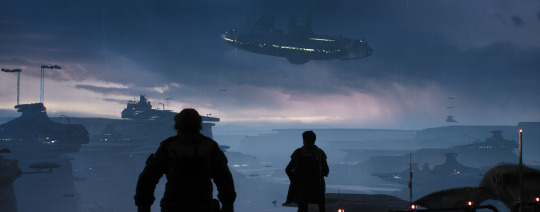
The burnt out husks of the republic, separatists and the clone wars are being brought down to shipwrecking planets like Bracca to be stripped for valuable parts, melted down and recycled into materials that will construct the empires growing imperial war machine fuelling this transition.This is all carried out by overworked and underpaid engineers turned scrappers... This location also serves as a fantastic opening to the game! Giving us a believable insight into how the aesthetics and technology of this galaxy changed so drastically into the one we are all familiar with.

All of this world building is organic and we get to experience the emotional and political impact of this new reality at the same time the character we play as does. Cal Kestis is a jedi padawan who has gone into hiding after the events of order 66, and it is here he has spent most of his young life dismantling the world he had once known to blend in, waiting for any sign of other surviving members of the jedi council to hopefully tell him what to do next and its fantastic juxtaposition. We see him and his friend Prauf running through and scaling the dangerous work environments of this planet talking about their hopes and dreams for a future outside of this depressing place.
The heroes journey is an essential part of STAR WARS storytelling.
youtube
Prauf being the oldest wants Cal Kestis to someday find his destiny and tries to motivate him to do so. As you can see there, the performance capture on this character even Cal is incredible and you really feel the emotion in the dialogue. Layered within this endearing narrative is great foreshadowing of events to come, political commentary and emotional content, this is stuff that I wish the Lucas directed star wars prequels were better at. But regardless its amazing to finally see it done so well here.
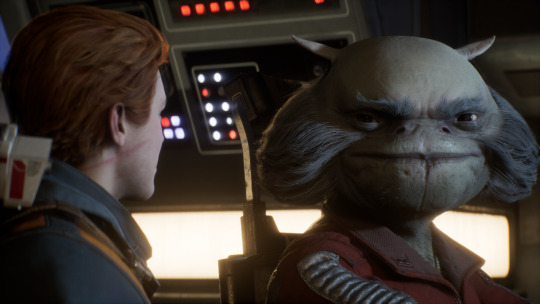


Jedi fallen order is not just an exciting star wars action adventure game with sleek mechanics, its also an intriguing narrative that shows us how survivors of a gone away world cope with the loss of that civilisation and their role within it. The game is full of great characters who assist and motivate Cal on his journey to discover hope for the future! I dont want to spoil too much of it because its really something you gotta experience for yourself to fully appreciate.
These qualities will also be expressed in the next three pieces of bridge media ill review.
SOLO A STAR WARS STORY 2018.
This is the second movie to be released in the STAR WARS anthology movie series. In it we are shown the backstory to one the original trilogy’s most recognisable characters Han Solo! While it is not a perfect production (What star wars movie is?...) its still a fun and exciting adventure full of style.
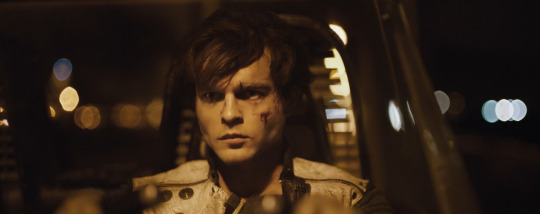
Like with Fallen order we get a detailed look at the ways in which the empire is taking control of the galaxy not just in terms of society and culture but also on the economic level, and it all has some interesting real world parallels. On the planet Corellia Han and his girlfriend Qi’ra are trapped in a life of crime for the local gangsters who use orphaned children as a means to carry out scams and steal expensive vehicles from rival gangs and even the wealthy elite. Discovering a rare resource on a job which is used by the empire to power their enormous starfleet, Han steals this along with a lighting fast speeder to outrun their masters and hopefully bribe the imperial guards at the immigration port checkpoint to then escape off world for good.

Its through this impressive opening sequence that we get an insight into the class divide of this universe and how the empire oppress and exploit populations of the worlds they control, we are even shown how they collude with the gangs to funnel desperate youths into recruitment offices for the empire’s vast military. Again its all organic, interwoven with the narrative of the character we follow. We experience it as they do! With shots of the newly constructed empire star destroyers that we saw were built with the re purposed scrap seen in Fallen order for an example.

This is what STAR WARS excels at, wrapping interesting social commentary and scifi themes around a fairly simple heroes journey. There is even more of this stuff too throughout the rest of the film, like we see in vivid detail how the empire sends the poorest of these worlds to fight in off world conflicts across the entire galaxy to eliminate native resistance and install a regime loyal to the emperor. It is fascinating way to show how oppressive and brutal this fascist empire is... When Han’s escape plan fails and he is separated for Qi’ra, he is then forced to escape from the gangs and imperial authorities by posing as a civilian looking to become a soldier in the empires army, though he does not get to be a pilot like he imagined for long. Han is thrust into a survival situation, as he and many others like him are forced to fight in a world war 1 inspired hellhole.

We see thats its not just elite storm troopers that compose the empires forces, but also these scarcely equipped mud troopers comprised of the working poor. After these amazing sequences the film settles into a more predictable heist narrative with a ragtag criminal crew, seeing Solo develop into the character we all know and love from those original films. Finding Chewie, getting the Falcon, his iconic Blaster, meeting Lando you name it and its all here!
Solid stuff.
STAR WARS THE FORCE UNLEASHED 2008.
Originally intended to be the official bridge between REVENGE OF THE SITH and the 1977 CLASSIC STAR WARS. This game tells the tale of Darth Vader's secret apprentice Starkiller, who is tasked in eliminating the emperors enemies and former Jedi.
youtube
The game received very mixed reviews upon release as it was criticised for being perhaps a little rushed and a very bland button masher in terms of gameplay mechanics. Though the way in which you could use the force was pretty impressive, especially when combined with very impressive physics systems. What ultimately makes this game so interesting is its story, showing us how Darth Vader desires to escape the control of his master even while he still serves him... He uses Starkiller (Who was a child he stole from his original father/former jedi he was sent to kill), as a means to find the emperors enemies covertly, who just so happen to be rallying together to fight against the sith lord. In so doing Starkiller becomes a double agent, encouraging the formation of this resistance while at the same time killing Jedi to appease Lord Vader and aid his secret plan to assert control of the empire from within.

Over the course of this journey Starkiller will eventually grow to be sympathetic to the rebel cause and fight for the freedom of the galaxy, though I wont spoil the specifics here.
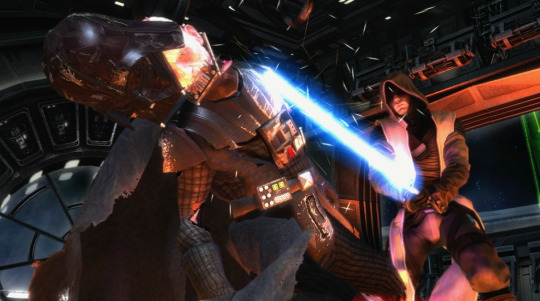
Like with the previous media shown in this review we get even more glimpses into the ways in which this galaxy operates, and also how the empire operates. We see junkyard planets filled with the remnants of the clone wars, a deathstar in a very early stage of construction, and small insurrections formed by a surviving Jedi striking at the hearts of the imperial war machine. Its pretty similar to how Fallen order does it, but I feel that Fallen order does a much better job at this while at the same time being a phenomenal gameplay experience.
Despite its flaws though FORCE UNLEASHED is still a fun adventure that fits surprisingly well in the overall narrative i’m experiencing here chronologically! :D
ROGUE ONE A STAR WARS STORY 2016.

The first movie in the STAR WARS anthology film series, ROGUE ONE does everything that SOLO did right perhaps even more so! This movie takes place directly before the events of the 1977 classic, showing us the daring mission to secure the Deathstar plans that Luke then stumbles upon. What is so clever about this narrative is how it wraps a human story around such a small annoying detail in a new hope relating to the Deathstar’s ultimate weakness we are all aware of. The thermal exhaust port...

ROGUE ONE shows us how the empire exploits the minds and talents of the galaxy’s brightest individuals to construct its oppressive technology and weapons, destroying livelihoods and families in the process as we see in the opening. Galen Erso, a former lead scientist for the Deathstar super weapon project has gone into hiding to avoid aiding in the empires efforts to construct it, becoming a moisture farmer on a remote world. Much to his dismay, Director Orson Krennic a high ranking imperial officer he was once associated with has discovered the location of this farm and intends to bring him back to finish the research on the weapon.
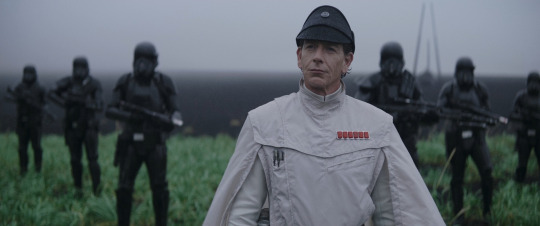
Foreseeing this eventuality that he will become a hostage to the program, he devises a plan to hide his wife and daughter from the empire while he attempts to avoid being taken away, something that unfortunately is unlikely to happen... The plan does ultimately fail and his wife is killed, while only his daughter manages to escape Krennic’s elite bodyguards. Its a very emotional and impactful opening sequence that has real world relevancy, the history of WMD’s are full of personal tragic complexities like this for example.

Jyn Erso, Galen’s daughter is orphaned by this event, growing up to become a member of local rebel groups until becoming disgruntled and solitary. When broken out of imperial prison she will soon realise once tasked by the Alliance to retrieve information on the Deathstar that her Father is still alive, and while forced to work on the weapon placed a weakness in the design of the station the rebels can exploit. The groundwork for his revenge. The scene where she views the message made for her is amazing, see for yourself.
youtube
Its very well executed and the emotional impact of the scene really makes it heartfelt while also expanding the universe in a really unique way! The climax of the film expertly shows us the bravery and sacrifice involved in a mission like this aswell, but I wont spoil it go watch the movie yourself to see :D. Again like with the other media shown, it sprinkles in lots of social and political commentary in its visual world building.
This is what a STAR WARS prequel should do!
youtube
I hope you enjoyed these reviews and are encouraged to add these films to your viewing list :). I’m now going to be rewatching the 4k restored theatrical cuts of the original trilogy then playing battlefronts 2′s singleplayer so stay tuned for those reviews once they release!
2 notes
·
View notes
Text
Why Persona 5/Royal means so much to me and how I view my bonds (ADDENDUM: SPOILERS WILL BE INCLUDED - YOU HAVE BEEN WARNED)


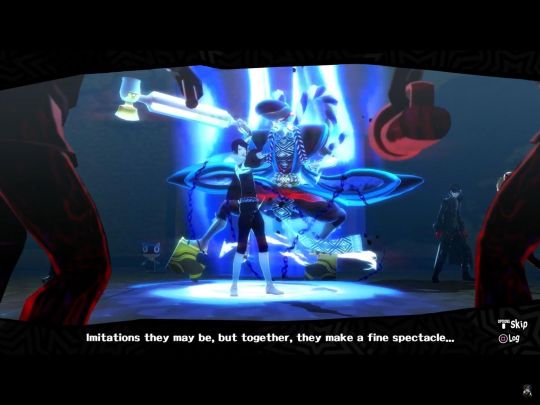
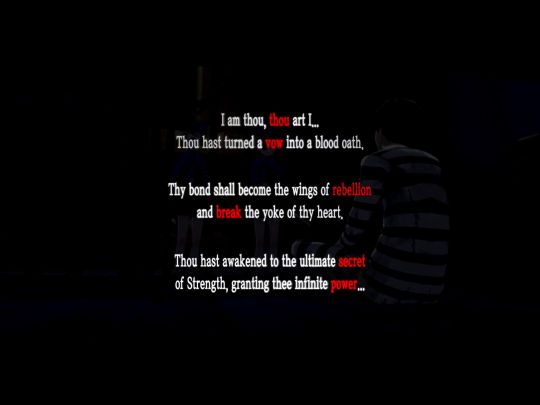

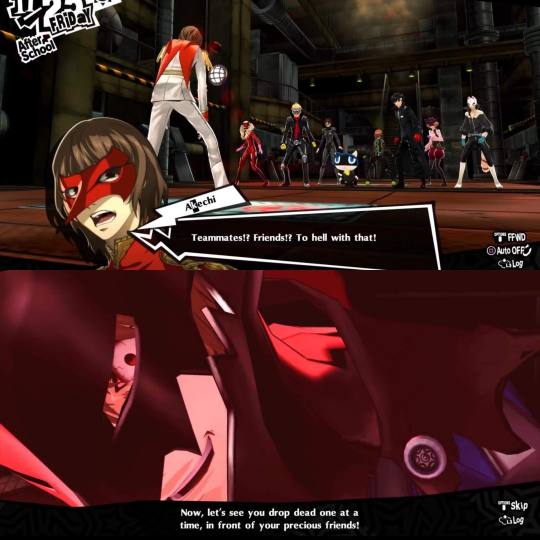
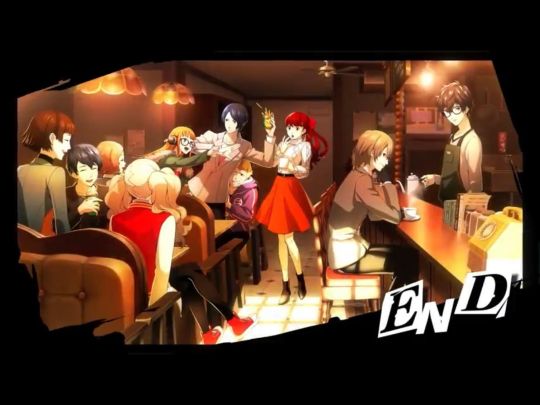
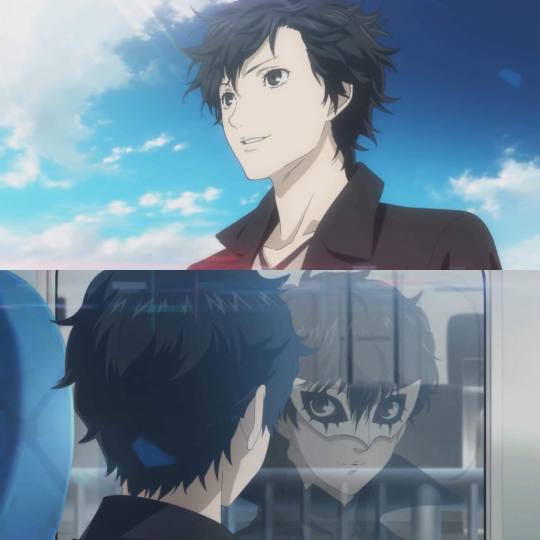
As I am writing this, I am 7 years past from conventional Australian high school life and just about a year past from graduating from university life. With adult life, it is tough to create time for yourself, let alone for your friends. Each and every one of us have different priorities: work, further studies, family, kids, bills to pay, etc. In addition, an actual health crisis in COVID-19 on top of the already giant wave of cynicism that we’re facing about the world from years prior makes the future seem pretty bleak. Wearing masks, following proper hygiene and especially social distancing is consistent globally (or at least should be while we’re still dealing with COVID-19). Sure, we can use technology as a way to connect, and it undeniably helps in maintaining our bonds, but it is not the same as actually being in person and spending time with them. With the epidemic putting a worldwide stranglehold on everyone, along with the stresses of growing up, creating and maintaining our bonds became a lot more difficult.
So random question: What do you think of when someone brings up Persona 5 (P5) or Persona 5 Royal (P5R)? A masterclass of dynamic visuals and flair that is distinctive and aesthetically and thematically fitting our striking and rebellious protagonists in the Phantom Thieves? Top tier soundtrack? A fantastic turn based RPG system based on combos, follow-ups and support? Or maybe the personas themselves being the manifestations of the inner self and reflecting one’s inner strife and turmoil like dealing with death and grief (P3), or handling and understanding our true self (P4) or rebelling against corruption as we mature in an unjust world (P5)? All legitimate answers. Just a small addendum: P5R is an enhanced version of vanilla P5 that adds more personas, tweaks the combat and level up system to make it more seamless but compensates it with more intelligent A.I. and especially added story content (we’ll especially get to this part later). Yet, when I think about this game, I think about the social simulator aspect that works in tandem and beautifully complements the RPG gameplay where we explore the supernatural world of that particular Persona game. In both games, it acts as a way to worldbuild the busy streets and areas in and near Shibuya. You’ll encounter many different key support characters, within and outside the main cast of your group, the Phantom Thieves of Heart. By getting to know these characters and ranking up each confidant (maximum rank is 10 for each), you will be able to access a whole plethora of special abilities such as: learning new methods to down opponents instantaneously, access to personas only available by maximising each confidant’s rank, access to immensely helpful combat and support items and methods and especially the transforming your team member’s initial Personas into stronger forms. From a narrative perspective, you will get to know each character better, as they vent and confide their hopes, dreams, fears and desires whilst each of their stories fit with the major themes of maturation, finding your own road, rebellion and corruption. Yet, you can’t just immediately get to know all of them at once. In game, you’re just a transfer high school student. While you have free time, similar to real life, you have to make a choice on how to use it. Should you spend time getting to know a person? Or maybe level up one of your social stats like knowledge or kindness? Or working a casual job to get money? Maybe tackle one of those side missions? There’s no “correct” choice on how you spend your time. Heck, it is even more interesting that these are all optional. It is up to you whether or not you get to learn these characters and get to know them. Some are completely missable if you don’t explore hard enough. Essentially, on one side, you’re just a normal high student that unfortunately was dealt a terrible hand and on the other, you’re the leader of the Phantom Thieves. Codename: Joker.
Since P3, the social link/confidant system I just described uses a very interesting motif: the tarot card system. As the protagonist of your story, you are the Wild Card - Arcana Number 0: The Fool. In order to attain a form of enlightenment at journey’s end, also referred to as the World Arcana, you will encounter many other Arcana before reaching said end. Each significant social link/confidant you meet in-game, regardless if they become a party member or NPC, are each represented by one part of the Arcana series. This is due to symbolsing on what kind of individual and personality they have but also what challenges they need help overcoming and what they represent to the in-game protagonist of each game. Mind you, it has been stressed that any character that fits any of the arcana cannot be those who will only be friends or acquaintances within a superficial nature. It has to be a close, trusting friendship that grows with effort and time. Here are some examples. Those who represent the Emperor are often male characters who try to control their own surroundings but are troubled by something(s) very personal and don’t know how to deal with it. Characters that fit the Temperance are those who struggle to find the harmony and balance that they desire. And those who suit the Hermit arcana tend to the smartest people that you will meet but tend to be introverts or those who desire more supportive roles. We’ve definitely met people within our lives that fit the criteria of the noted examples. Yet, by meeting these types of interesting people within our lives, through that time and effort, both sides can attain a form of wisdom and learn from each other. I’ll use an in-game example: Toranosuke Yoshida. To Joker, this confidant is represented by the Sun Arcana. Anyone from this group tends to be people who are on the surface have a sense of confidence, hope and optimism but ironically find themselves in terrible situations that constantly hurts their self-esteem, self worth and constantly questions their own purpose in life. For this game, he is an optional social link that can only be unlocked after taking on two shifts within the Beef Bowl job at Shibuya’s Central Street. He is an eldery gentleman and a politician who hopes to make amends for his terrible and corrupt mistakes of the past but also to make a positive change in a stagnant Japanese political system. He is seen making an earnest effort in giving speeches in front of a crowd near a subway’s gateway. Although demonstrating impressive speech-giving skills, as soon as a critical voice in the crowd shouts out “No-Good Tora”, his past regrets and lack of self-esteem shows and loses the crowd’s attention as he cracks under negative pressure. By meeting him, he found a youth who is willing to believe in his message, support him in his live speeches and also a hope of a younger generation that is willing to make a change. While the MC found a redeemed adult, after dealing with corrupt adults, and who is willing to learn about his diplomatic and speech-giving skills. As you rank up his confidant, you get to learn to negotiate with downed enemies for more money, rarer items and to possibly join your team, alongside unlocking the fusion recipe for the strongest Persona you can obtain from this Arcana: Asura. In the narrative sense, he starts to gain his confidence and learn on dealing with voices that are critical or even adverse to his live speeches and even flip the momentum back into his favour, while still being respectful and charismatic. In the conclusion of his confidant link (Rank 10), after several distinct story content relegated to his arc (which I won’t spoil), Yoshida gives a heartfelt speech in front of a larger, excited, more supportive crowd than from the past. Not about the current government. Not about his desire to be a part of the Diet Building. But about how he met this young man, although with different methodologies, is trying to reform the world. Yoshida admits that it seems like a tough mountain to cross. His anecdote gives an impression to the audience that this young man reinspired him to go for his aspirations and reminds them to go for it as well. Even though they can’t share the same path, Yoshida confidently states that they “will surely meet at the peak”. He admits from a previous speech that his efforts may not be heeded now but will hopefully be a stepping stone for future generations. Before that final speech, in private, he deduced that you were a member of the Phantom Thieves but won’t meddle in your affairs. If anything, he respects their tenacity and vision. It’s not even the most emotional nor most dramatically interesting confidant or story. Yet, it left me with an amazing impression that through weird, random scenarios and situations, you can meet people who are worth meeting and understanding. In greater reflection, although I am blessed to have both quality and quantity in terms of my major friends, if I were to apply this motif in how I view my bonds, I could say that each of their personalities and stories can represent each part of the arcana, with definitie overlap in notable places. With just some examples, with the people I’ve met, I’ve learned to be a bit more confident in my skills, embrace my tastes and hobbies and understand from their faults and failures as they have from learning from my own errors and mistakes. You could say that in my journey through life, to evolve from the Fool and learn some knowledge of the World, I encountered and befriended many people from many different backgrounds, cultures, tastes, personalities and worldviews and appreciated every single one of them. I hope that maybe by spending their time with me, they gained some sort of food-for-thought advice that may help them moving forward in conjunction with knowing they have a friend in me.
Then there is the ending of P5R’s 3rd semester. Exclusive to P5R, it can only be unlocked after meeting certain criteria. What I loved about this arc would be that it was largely teased and set up from previous moments in the game. Without spoiling the meat of the story of this arc, it added an intriguing layer of nuance and depth to the aforementioned themes surrounding the game and also added one more thought-provoking theme to the mix: stagnation. Before continuing, I think it is best to first address vanilla P5’s ending. Joker and the rest of the main cast finally helped stop a potentially world-ending crisis and retire from being Phantom Thieves. With the MC moving back home, instead of just saying one final goodbye, the group of friends offered to drive him back. On a near empty highway, the clear skies and the open breeze. The future doesn’t belong to anyone but ourselves and we can see how bright it is, together. Now let’s go to P5R’s two major endings. Yes, you heard me right. The final antagonist essentially created a world where the deepest wishes that a character has is granted and the greatest regret and/or wrong is corrected. For example: Haru has the close relationship with her father she always wanted...even though he died during the main story via previous events. Morgana finally got to be a human...even though it spits on his previous acceptance on what he actually is and his true role to the main cast. Essentially, everything seems so perfect yet everything feels so wrong. Before the final confrontation/boss battle, the final antagonist offers one final choice to the MC. Will you allow them to take over the world and allow yourself to live in their version of “paradise”? Or will you reject it, willing to go on and continue onwards and forge the path that you desire, even with problems persisting throughout? Let’s say you choose the former option, what happens? In summary, whilst on the surface seems like a joyous ending, is actually quite haunting on closer analysis. While the crew can still stay together, the MC doesn’t need to leave Shibuya, Akechi is alive and Kasumi is happy, it still seems off. Yes, the main cast gets their wishes but it also ignores the challenges and tribulations each member went through that built their inner strength and ideals. There's a group shot at the end at LeBlanc’s with everyone in frame. Everything feels right but the MC and Akechi are looking at you: the player. In this arc, they were the ones who, plotwise, were against the entire idea of submitting their future, morals and ideals for an easy way out. You gave up. Notice it says “END” at the bottom right? You chose a stagnant future. Nothing goes wrong but nothing progresses. A beautiful lie. There’s nothing beyond this. But what happens when you choose the latter option to reject? Post final battle, it is not only the final disbandment of the Phantom Thieves but also a parting of ways for the main cast. Ryuji is moving away in order to return back to the track team and have rehabilitation for his injured knee. Ann is planning to do some studying abroad for her future career. Yusuke has greater inspiration and motivation to return to painting. Makoto and Haru are planning to move away as well for their own higher education and individual career aspirations. Futaba finally breaks out of her shell and plans to enter high school and research cognitive psience in college. In his rejection of a false paradise, Akechi is finally able to rest in peace. Sumire, with a renewed heart, will no longer linger behind in her late sister’s accomplishments but achieve her own feats and achieve her and her own sister’s connected dreams. And finally, Joker will return to his hometown, with Morgana joining him. Instead of one final car ride together, Joker and Morgana, after saying their final goodbyes, take the bullet train home. To say that it is bittersweet and left me in shambles is an understatement. But yet, it is the perfect ending and an interesting twist to the original P5’s ending. It redefined the major theme of freedom. P5R
took a bold approach in saying that we each have our unique path in life and must walk it, even if it may be “alone”. However, with the bonds that we’ve beautifully weaved, those that are true will always return to each other one day. In P5R’s true ending, it closes with “FIN”. Although it is finishing this story, there will be another tale right around the corner for us. It further re-emphasised and reminded me of my current viewpoint and situations with all of my friends as someone removed from both high school and university life and made their way into the real world. As I’ve explained before, it is nowhere near as easy as it once was. We are all no longer connected by a mutual place where we can easily just hang out and create random memories, where creating time is not a worry. That each of my closest friends, even with similar interests or dreams, have their own distinct aspirations and futures. Hell, I’ve made a lot of great friends but because of a number of reasons, I just felt time made us further distant from each other and making those fun times feel like several lifetimes ago. It feels disheartening and cruel but those who matter will find a way back or remain in contact. I want to share a small anecdote. I just randomly messaged one of my old childhood, primary school friends to see how they are going with life. What was supposed to be just a quick checkup between two old friends ended up being an impromptu, primary school reunion of up to 7 people (including myself). Mind you, I haven’t seen some of them in person for 5+ years. And yet, it is one of my favourite memories as of yet. We’re all walking different paths but felt amazing to see how each of them are going with their own personal journey and their growth. Just with this group, I have no clue when we’ll have something similar to this again but even if time may separate us for years, we’ll find a way back to hang out once more.
Another thing that this game helped reminded and re-emphasised me of, would be how important YOU play a part in your friend’s lives as they have to you. It sounds narcissistic but let me explain. In the game, at the very last day, you will say your final farewells to your teammates and all others who played a part within your journey. If you max ranked the confidants outside of the main cast, you definitely feel the greater impact and appreciation of your effort. Kawakami is no longer bound to a double life and has her passion to teach again. Iwai doesn’t need to hide his Yakuza past nor how he brought in his adopted son and finally has a new chance to be the father he always wanted to be. Yoshida finally has the confidence to not only acknowledge and learn from his corrupt political past but also has the greater confidence to move forward and stand for the younger generation who aspire for a bright future. These are just some of the examples of your effort bearing fruit. I will admit to doubting that my efforts are really helpful at all. I think for the most part, at best, I’ll just contribute a minor part to their happiness and/or growth. Yet, similar to the game, you will meet people that are legitimately grateful for your presence, time, effort and love. It is still crazy to me when someone affirms me and is grateful for my efforts when I spend time with them. That especially goes both ways as I feel immensely happy that there are those who are willing to take a risk and make time for some random idiot like myself and get to know me and who I am. Mind you, my love languages are Words of Affirmation and Quality Time. Regardless of whatever you believe in, may it be God, the universe or coincidence or dumb luck, it genuinely warms my heart and soul and eases my mind to know that effort to make time is worthwhile and to be acknowledged for my efforts; as if I met these people, and maybe even more, at the right place and at the right stage of my life. Regardless of when you met a close friend, do not underestimate your impact (something I still need to learn myself). You never know if what you do for them may be one of the things they need to see and hear.
Friendships and bonds are important. It sounds so overly played that the moral goes beyond a cliche’ and became a meme. Yet, both iterations of Persona 5 was a game I needed for my post education life - entering the real/full time working world. In an era where the world seems so divided and that time has separated each of us to our unique paths and made each other so distant, P5 and P5R allowed me to reflect on how I viewed my own bonds with closest friends in a new era of my life. It made me appreciate my current bonds on a whole new level. I don’t know who needs to read this right now, but thank you for being there. Even if I just met you just the other day or we’ve been friends for many years, please know that I appreciate you for who you are and what you mean to me. Thank you for giving some part of your time to make mine feel just a bit more timeless. I hope, even in our twilight years, that we continue to make many memories and grow within our bonds. To those who I’ve failed, I apologise. I have no idea if we can reconnect and make it the way things as they were before or allow time to walk our own paths but I hope you will find the happiness you deserve. If we do reconnect, I’ll do my best to keep improving as a person and as a friend. Just know that you are not worthless and you’ll always have people that do desire to be with you. Even with more grim scenarios, I know you’ll meet people who WILL be there for you. It’s tough to execute in practice as we go forward but not impossible to make the time and effort. I want to end this blog with a quote from Ann to the player as the MC prepares to say goodbye to all his closest friends and confidants (via the new true ending from P5R): “I’ve gotta reach people. I wanna give someone hope - like you did for me. Thank you for all you’ve done. The days I spent with you were some of the brightest in my life. Once I’m a star, I’m gonna shine even brighter, though - so watch out for me!”
Addendum: Sorry for being so late on this post. A lot of stuff was happening on my end and I wanted to make sure whenever I write a blog post, I write with the right mindset as I want to make it as genuine as possible and speak from the heart. I hope you enjoyed reading through this one. Next to Super Mario Galaxy, Persona 5 (more so the Royal version) is one of my favourite games of all time (currently my 2nd at the time I’m writing this). I definitely wanted to discuss its impact on me, similar to Galaxy. Hope you guys are doing well and will look forward to my next discussion topics that lie ahead.
0 notes
Text
Once More Without Feeling
So about 100 years ago when we were still in the middle of Rueshima, I published this meta. This was of course before our lives got flipped turned upside down, and Furuta told us all how he became the king of the Washuu
The point is of course now that 1,000 years have passed, a lot has changed since then in the narrative. Just recently in the last three chapters alone we have had references to characters overcoming impossible circumstances, and power gaps through the strength of feelings alone.
The obvious difference this time is that in my last post I said quite clearly that existing outside of the rigid structure of the CCG’s world is what allowed ghouls to feel things more freely, and therefore access the strength of their feelings whereas the CCG were fighting without feelings, and therefore unable to tap into their true power. Matsumae was fighting to protect her family, whereas Hairu was just fighting to slaughter, that sort of thing.
However this time, all three of the characters who are shown gaining access to their feelings for a source of strength are CCG members rather than ghouls (Urie, Furuta as a Joke, Mutsuki).
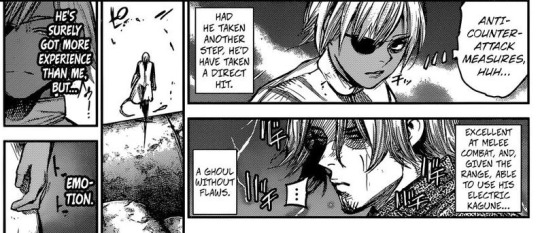
That can’t be right though, because Yomo has already made it clear and had his emotional flashbacks about how his purpose in life was to fight and protect the remaining family he had left.
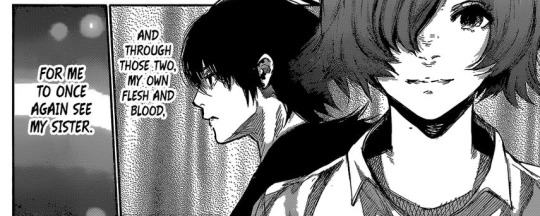
Yomo already has it clearly figured out what he has been fighting for and the emotions he holds towards both of the Kirishia siblings, whereas what Mutsuki is fighting for is pure delusion over a romanticized past.
However, there is a clear difference between Yomo at that time, and the current situation. Just as there has been a significant change in Mutsuki in response to the CCG. Simply put, the changing cultures of both the CCG under Furuta’s reign, and Goat under Kaneki’s reigns, have also changed the way their individual members deal with their emotions.
It’s become flipped to the point where members of Furuta’s CCG are encouraged to overindulge in their emotions, whereas Kaneki’s Goat are shown repressing themselves greatly in order to work together. Which, seems to be the exact opposite of what you think it should be, especially with the way Furuta seems to treat emotion in general as nothing more than a joke. Whereas Goat most of their focus chapters are about characters going into long dialogues about what they are feeling with other characters.

It’s as the narration says, because Goat is an alliance of more emotionally involved people they have their entire organization shaken by the awakening of one person, whereas the CCG which is used to repressing their emotions and carrying on business as normal is therefore not shaken up. Yet, of course we see the opposite happening actually. The CCG gets totally shook... shaked... shooked....


The investigators scream out to show their approval of what Furuta did. That’s hardly being emotionally reserved. The next scene even says so, Furuta is different than other chairman, he’s much more open to the public about the gory details of what he does.

This is Furuta’s CCG, this is what it encourages. Screaming, applauding, giving yourself away to your more baser emotions and let yourself being slaves to them. There’s no repression involved, rather it’s almost an over expression. You can see this in the people Furuta specifically taps himself to be around too.
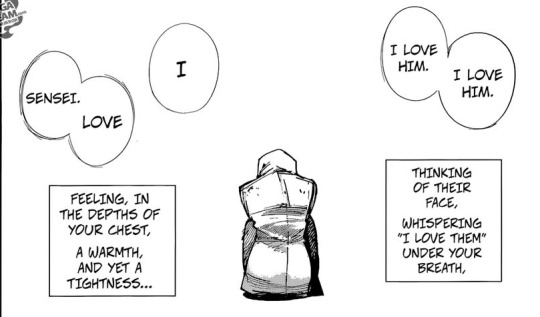
Mutsuki flips like a switch during the clown raid and gives into his one long time repressed desire. It’s also important to mention that Mutsuki was one of the most repressed characters in the series to begin with, there is of course his habit of lying but before that he also regarded his own expression of emotions such as anxiety and fear as weakness during the auction raid.

Mutsuki’s emotions, his anxiety towards blood, his fear towards hurting others and the untapped power of a ghoul all of those were considered weaknesses that Mutsuki had to overcome.
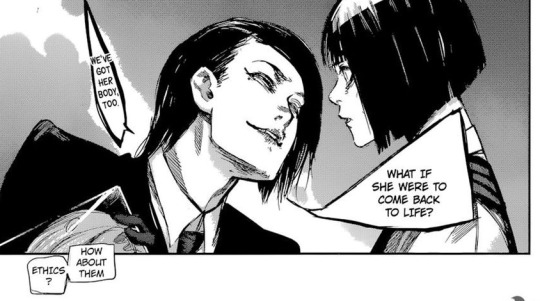
Ui literally gets tempted to abandon all of his ethics to pursue his desire instead in the form of Hairu ala a faustian bargain, and he seems very much aware of what he’s choosing.

Aura goes from a quiet and unseeming kid, to one constantly holding back anger and obsessed with vengeance.

Juuzou even too, who was specifically chosen to be Arima’s replacement is also finally hung up on his own feelings about Shinohara. Juuzou admitting this directly as the reason for his fighting is still a pretty big change because at the beginning of Re: it was mentioned Juuzou was too hurt by the idea of Shinohara in a coma he could not even visit Shinohara in the hospital.

Whereas when Juuzou is discussing what to do next with Iwao, it’s in Shinohara’s hospital room, the place he had not been able to visit beforehand.
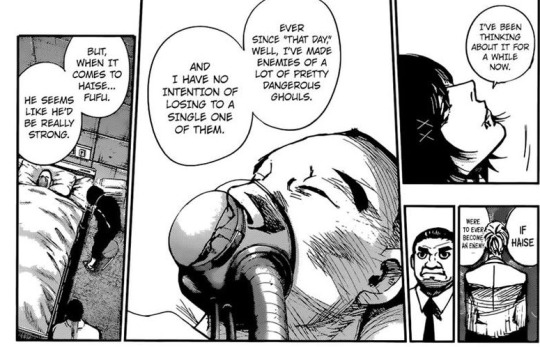
Even though Urie also directly rebels against Furuta, the revelations that he comes to only happen because of the pressure created by Furuta’s regime and his own disgust in reaction to it.
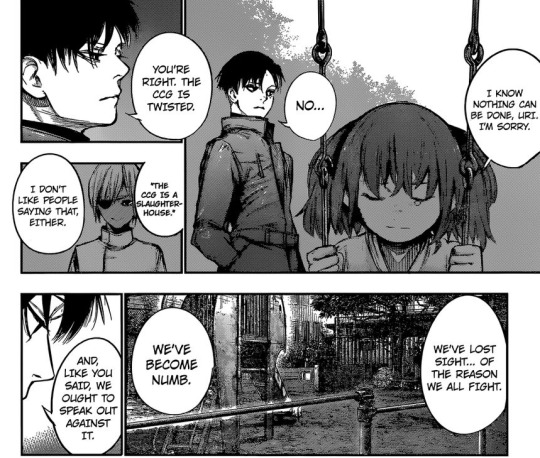
It’s the environment that Furuta creates that leads in reaction to Urie realizing both his own emotional numbness, and also his ability to act on his feelings. If Bujin had not been targeted it’s likely that Urie would never have moved an inch in his grudge against Bujin and realized that he actually does not want to see the man suffer.

In making the CCG more brutal, effectively more ghoul like Furuta creates an unrestrained environment where emotions flow much more freely. At the same time he also creates an environment where people are enabled to entirely be controlled by those emotions, Mutsuki by his sense of abandonment, Ui by his grief, Juuzou by his pining for Shinohara.
On the flip side then, what has Kaneki’s environment which features long pondering of character’s own emotions encouraged.

It’s kind of amazing, how many of the long emotional debates just end with “You’re empty inside” as if that’s a fitting end point all on it’s own. Remember Kaneki made Goat on the legacy of both the one eyed king and Aogiri, but Kaneki himself is a former CCG investigator for three years.
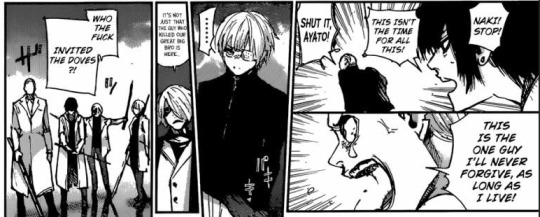

Kaneki’s own mission essentially requires everyone to forget about their own emotions of the past to cooperate in what is otherwise an unsteady alliance. Such as the way Tsukiyama forgives Kaneki in .01 seconds with no apology on Kaneki’s part.
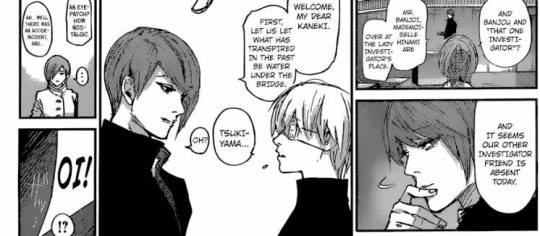
Ayato and Take both make a good observation as to why this kind of thing is happening though. Rather than mutual understanding, it’s more like every single person in Goat has come to depend on Kaneki Ken in one way or another. It’s not any actual conversation about emotions that’s going on here, it’s all one sided.


So we have all of these intense emotional discussions coming up relatively empty. Amon says that his ideas in the past have not changed even after talking with Kaneki.

Akira and Amon leave both to “contemplate their own emptiness”, having left goat bereft of any meaning only having been drained of their hatred after the whole experience.


Hinami speaks about how even seeing Akira reminds her of the tragedy of her parents, but none of those feelings get addressed. Hinami just suppresses them again, even though she specifically says that she does not want to become used to the feeling of being hurt about her mother and father’s deaths because that would be doing them wrong.

As I said a two way dialogue doesn’t actually happen. Hinami sucks it all up for Akira’s sake, and Akira walks away after that point now that she has the closure she needed.
That is probably the key problem with Goat, the environment of repression is created because everybody is afraid to step on the toes of the other. Perhaps because the leader who they all depend on is also an unstable person who, if is pushed too much or given too much to worry about, might himself wander off and die on them.
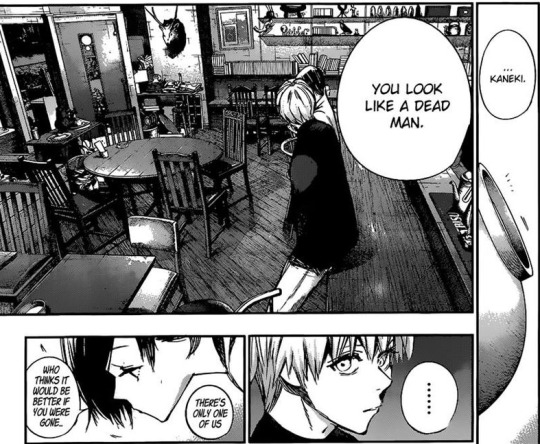

Something of which the members of Goat close to Kaneki at least seem painfully aware of. Hinami even says that her tending of Akira to her bedside was done for the sake of her big brother’s happiness, even though she admits later just the sight of Akira unnerves her that much.
So yes, Goat is constantly talking about feelings but it’s an almost always a one sided thing. We’re shown again and again people repressing their own feelings in an attempt to make the others around them happy. Amon gives up his search for meaning to help Akira find meaning, Touka seems terrified to tell Kaneki anything that might stress him out the smallest bit, Hinami quiets down and plays along with Touka and Kaneki’s attempts to rehabilitate Akira even though she’s the more hurt party.

Perhaps then it’s most embodied by this chapter, where even in deadly danger and helping refugees escape for their lives, Touka’s immediate thought goes to whether or not Kaneki will be saddened by this whole affair.

Because Touka’s first instinct is not to worry about her own feelings, but rather Kaneki’s. She drops her guard down and gets hit by a surprise attack. The manga goes at great length to establish that Kaneki is not going to show up this arc, and what’s discussed above is exactly the reason why.

It’s as Hajime said, Goat is useless without Kaneki. Not because most of the members cannot defend themselves, but thematically because almost the entire purpose and creation of Goat is just to give Kaneki a reason to live, and the organization’s cultivated dependency on Kaneki means that the organizations motivations have shifted not from their own feelings of self liberation but rather Kaneki’s.

Kaneki won goat’s loyalty with the promise that they could put all of their trust in him.
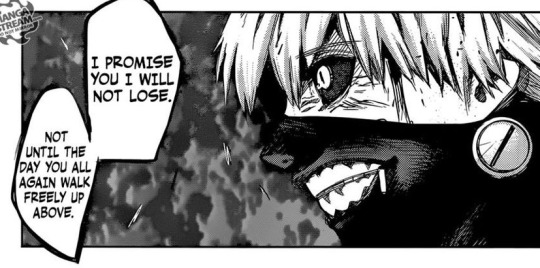
From the start though Kaneki’s priorities have been skewed, as he sees more humanity in the ccg officers he’s fighting, rather than the ghouls he’s meant to be protecting.
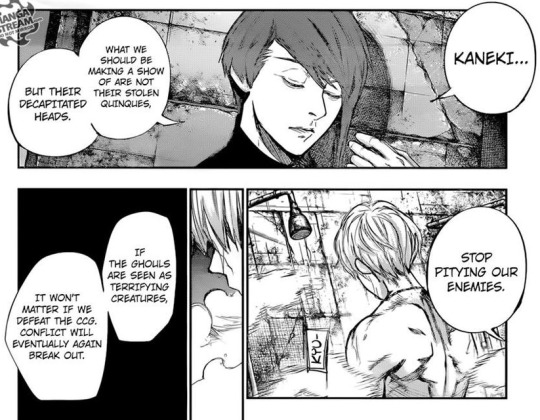
So with these missteps, the culture of repression that Kaneki has created the ghouls of Goat are not people of overwhelming emotion threatening to break the cage of the world through self realization, but rather they are referred to as beleaguered, air headed pacifists.


It’s quite obvious, the reason Amon, Akira, Hinami, these characters feel empty is because they are constantly repressing their own emotions. Akira immediately goes back to repressing whatever it was she felt about Seidou the moment she woke up, not even bothering to ask if he was around. Amon represses his guilt for what he’s done in the past. The two are constantly trying not to feel their own emotions, yet we’re meant to believe that they are rendered empty for other existentialist reasons?
So we finally get to the question of why Yomo’s emotions do not trump Mutsuki’s. Remember, Yomo’s last words.

The entire rebellion, in its refusal to directly confront the world and choice to hide away in the 24th ward and run from every major conflict, has come to embody the fatalism, the negative side of these words.
The obvious counterpoint is that ghouls do not have to live this way. Kaneki seems to grasp it a little bit, as he begins to imagine a future with Touka. One that is dependent on creating a world where ghouls can walk in the open and therefore their relationship will be allowed.

However it’s one that Yomo and Touka never have, both of them have simply gotten too used to the idea of losing things. Rather than react to it and try to protect things, as mad as Mutsuki, Kaneki, and Ui might seem when they get wrapped up with their emotions like this and try to do the impossible, Yomo and Touka go the opposite direction and lose all interest in fighting the world whatsoever only focusing on accepting each loss and being able to move on from it.

So that’s why Yomo’s emotions lose out to Mutsuki’s, because Yomo was never fighting to win to begin with. For him, everything is already squared as long as both of the living remnants of his sister live on with him.

He’s fine with it, he’s already made his peace. While it makes him more mature, it also makes him unwilling to grasp the obvious. That there does not have to be a future where either he or Touka dies.
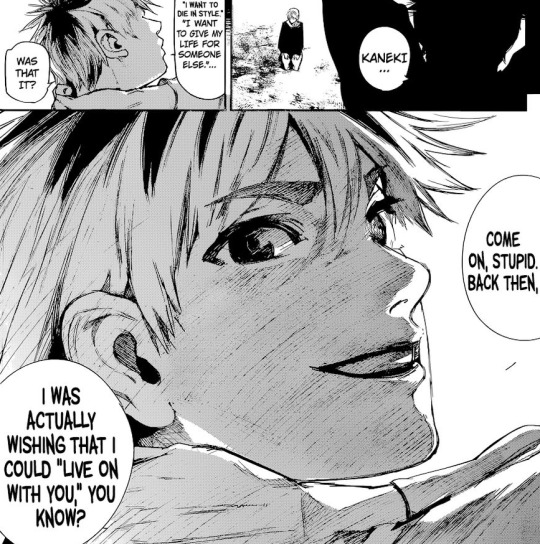
It’s as Hide said, rather than dying so somebody else can live, isn’t the better ending where they both live on together. That’s clearly the ending Kaneki wants to fight for, so it’s odd we see such emotional repression for the sake of others,a and self sacrifice in the ranks of Goat.
Just this once, can’t everybody live?
127 notes
·
View notes
Text
[Rewrite] “Is Lars Going Evil?!”
"Did Lars go evil?" "Lars of the Stars? Evil??" "Is Lars going evil?!"
No. No, he is not.
I would say it’s bizarre the fan theorists were so quick to go there in reaction to Captain Lars laughing like Lelouch in the recent SU leak, but I honestly don’t know what I was expecting.
Lars is the last character I would expect to turn evil at this point. Not between appearances at the drop of a hat with absolutely zero build up. If fans think he could, then they still don’t understand his character. That door was sealed shut in Wanted. Not that it was ever built to open to begin with.
The show spent four seasons (technically three) insisting in every way it could that Lars is a good but very flawed person who wants to be good beneath his uncaring jerk facade that's always been implied to be a defense mechanism. This was even one of the things many fans cited to be a huge source of frustration with his character before Season 5. Outside of openly stating it through Sadie and Steven, the show kept him surrounded with symbolism and foreshadowing to this effect at all times, even using elements of the Hero's Journey archetype during the final episodes of Season 4 and throughout the Wanted special for Lars' personal arc, with Steven playing the part of the mentor to his hero.
The Wanted special heavily utilized the Rule of Three to emphasize just what sort of person Lars is underneath his mask of not caring. Three times, Lars expressed frustration with his constant state of fear with specific mention of wanting to help others. Three times, Lars lamented acting cowardly in the face of trouble, running and hiding when others needed him. Three times, Lars faced a dilemma where sacrificing himself was presented as the only option to save some kind strangers he just met. And he did. And died.
Despite fear and uncertainty, and even though he was the only person present who would've been safe from harm had he done nothing, he still chose them over himself every time without hesitation, even suffering a brutal and agonizing death to protect everyone. Even after this, after being accidentally resurrected as a magical being that doesn't need sustenance and may or may not be immortal, he still urged them to use the portal in his head to go to Earth so they could be safe and live freely, knowing he would be trapped alone on Homeworld forever if they did.
Lars never even gives a self-benefiting second motive for wanting to be heroic at any point, something unusual coming from Steven Universe, which has previously come off as a cynical series when it comes to heroic motivation. He's not trying to fill someone's shoes. He's not naive about what heroism entails like Steven had been before Jasper came to Earth; he already understands and fears the danger. He isn't fighting to honor someone's memory. He's not fighting for a place where he can be himself. He isn't desperate for there to be more to his life or seeking an escape from an ordinary life. His motivation doesn't seem to be a desire to protect his home planet either, since when he finally rushes into action, he's on an alien planet (in an entirely different galaxy from Earth) and protecting a group of helpless gems he’d only just met and had cowered from behind Steven only a minute before.
Prior to meeting the Off Colors, his typical reaction to stressful or dangerous situations was to either lash out at his friends, run away, hyperventilate and suffer a panic attack, or cry like a small child. Before he died and came back with Lion's powers, he was just an ordinary mentally ill teenager with anxiety seeking social acceptance. Lars never had anything to gain from becoming a hero nor did he show any sign of craving adventure, finding it terrifying and stressful, and yet the underlying belief that he couldn't be a hero, couldn't do anything, because of his fear (because "heroes are never afraid") left him in tears. And that was it. I could understand if the narrative left it at "he feels ashamed for fleeing when Sadie needed him" but it doesn't. That was presented as merely the breaking point.
For a long time, I was actually really confused by Lars' actions in Wanted. I considered the possibility that Lars might've wanted to punish himself for his past cowardice and poor treatment of his friends. I was even somewhat convinced he must be a death seeker or at least a martyr without a cause. Why else would he risk his life and sacrifice so much for people he just met without hesitation?
It wasn't until I scrutinized over his actions and dialogue in Wanted (and, indeed, throughout the series) that I realized this isn't actually indicated at any point. While he seems to romanticize the idea of heroic sacrifice on some level, referring to it as a beautiful act, he wasn't all that torn up when his offer to stay behind was rejected. Aside from a very brief confused protest, after they explained their reasoning for not abandoning him and accepted him as one of their own, he gladly accepted their decision with perhaps one of the most heartwarming smiles on the show to date. And though he was certainly full of regrets throughout Wanted, when he had the opportunity to perform a needless sacrifice during his fight to save one of the gems, he didn't take it.
In other words, while his own life was clearly not on his list of priorities, it doesn't seem like Lars was exactly leaping to throw it away either. He just wanted to protect everyone. Lars is just. that. good.
Then, after all this, as the cherry on top, the coup de grâce to the possibility of Lars reappearing as a villain next time he shows up, the end of his final conversation with Steven called to attention just how tightly his sense of self-worth is wound up in his mentality toward bravery and heroism one last time:
Steven: But it doesn't feel right to just leave you here.
Lars: You said yourself that everyone on this planet is out to get you. You won't be safe until you're back on Earth.
Steven: But, Lars-
Lars: Don't argue with me! You're always trying to help me. You brought me back to life. Just let me be somebody who deserved it.
Many fans, including myself at first, have interpreted this line to mean Lars doesn't feel he deserves to live and/or he seeks pay Steven back and atone for his past behavior and cowardice. I think both interpretations are true, at least to some extent, but the strange wording suggests something else: that Lars considers being brave and helping someone else, even if it's painful and means giving up something he wants, acting as a hero would, as being “somebody who deserved” to be brought back to life. Of course, to be selfish in regards to Steven’s safety after he’d just brought him back to life would’ve been reprehensible, but to say he wouldn’t deserve to be alive at all if he didn’t help him? That's harsh.
In light of Lars’ overall attitude and choices in Wanted, the implication of this goes even further. That without bravery and helping others, without turning away from his old cowardly nature, Lars does view himself as undeserving of life. That it’s through being brave and helping others, being a hero, that he truly feels he has any value.
And people think Lars could show up laughing mad with sadistic evil in his very next appearance? That doesn’t make a lick of sense. It would betray everything we've been shown about his character beneath his (now very broken) facade of being an uncaring jerk.
If Lars views himself behaving like a selfish cowardly bystander – a neutral party – in such a harsh and unforgiving light, how do you think he’d take it if he started heading down that path? Could the young hero who gave his life to protect some kind strangers and was willing to stay behind if it meant they would be free really dive into sadistic villainy without a second thought? Would he really be able to hold his head high after that?
The very first episode of Wanted made it abundantly clear that Lars admires and wants to be like Steven, who he has dryly described as someone who “likes everything” in the past. It is implied he has secretly felt like this for a long time. Unless possessed or absolutely brainwashed, Lars would know what he’s doing on some level. Steven would be helping people, not hurting them; he would care.
Even ignoring all that was said and done in Wanted, Lars is surrounded by friends to keep him grounded. If he does go evil, the Off Colors will try to stop their beloved captain and sworn protector or at least rebel against him, and Steven can literally find Lars wherever he goes as long as he has Lion. He would be a ridiculously easy to track villain and no trouble to detain. Even if he's learned how to create portals, he can't escape through them if he can't reach them. Lars becoming a villain would just be anti-climatic and serve no purpose other than throwing in some unnecessary additional angst for Steven and wasting a perfectly good character.
Besides, that would be too cynical for “there are no true villains” Steven Universe.
End Note: I do have more to say on the subject of Lars and morality, but they will have to wait for another time. This was just written in response to fan theorists jumping to the conclusion that "Lars laughing madly = Lars went evil" in his very next appearance after all he'd gone through to protect Steven and some kind strangers. Pretty sure Wanted constituted as Lars crossing the "Heroes' Frontier Step" (an act that shows a hero is playing for keeps; basically, the opposite of crossing the Moral Event Horizon).
Of course, there's more to the 18-second leak than a laugh, and context behind the laugh has been given by the person behind the leak (or at least we know enough to get the gist of the situation), but I have no interest in discussing the specifics here beyond stabbing the "suddenly evil" Lars theory with a logic fork.
Just... let the poor boy rest. He's earned it.
[original post]
[AO3 link]
#steven universe#fav: lars#the faves#my meta#fandom.exe#long post#i was dissatisfied with the original post#also i had more thoughts#so yeah.... i decided to rework it a bit for ao3
19 notes
·
View notes
Text
Final Paper
Gothic novels almost invariably feature an element of the supernatural between their pages. This magic or otherwise eldritch force can be on the side of modernism, such as in The Castle of Ortranto or otherwise a force of malevolence such as we found in Dracula. But in some cases, the Gothic novel rips the rug out from under us. In Northanger Abbey, the supernatural is firmly debunked and Gothic notions are cast aside. The novel fills in the gaps for us and shows the real horrors of the modern day. However, two other works The Turn of The Screw and The Fall of The House of Usher invite us to be skeptical of the supernatural without explicitly ripping away the veil. In this essay, I will compare these three works and explain what happens to the magic in each by the end of the novel and what the author intends by allowing the magic to be ambiguous or by thoroughly debunking it. After examining the three works seperately, I will then examine the particular techniques that each author employed to allow the reader to either fill in the gaps or how the use of the reveal moves the story forward.
Northanger Abbey is a gothic novel that is determined to break the mold of gothic novels. Jane Austen goes through the novel deliberately breaking gothic conventions on purpose. The first inkling appears in the second chapter wherein Catherine’s mother is supposed to act very worried about her daughter’s departure and warn her about brigands, but she merely asks her to “Her cautions were confined to the following points. “I beg, Catherine, you will always wrap yourself up very warm about the throat, when you come from the rooms at night; and I wish you would try to keep some account of the money you spend; I will give you this little book on purpose.”’ (Austen, p.17). Further examples of subversion can be found all throughout the novel. One in particular occurs when Henry Tilney shows up with a woman on his arm. There, Austen makes a point of noting that Catherine has “Thus unthinkingly throwing away a fair opportunity of considering him lost to her forever, by being married already. But guided only by what was simple and probable, it had never entered her head that Mr. Tilney could be married; he had not behaved, he had not talked, like the married men to whom she had been used; he had never mentioned a wife, and he had acknowledged a sister.” (Austen, p. 86). Austen goes on to use the subversions and the denial of the gothic to set up the real threats to Catherine Morland which come in the forms of James and Isabella Thorpe. Both of these individuals work to sabotage her in the marriage market, a greater and more real threat to her than her gothic fantasies.
But the most important subversion occurs with Henry Tilney when he directly confronts her about her fantasy world. His brief speech is found on page 353 wherein he says ““If I understand you rightly, you had formed a surmise of such horror as I have hardly words to—Dear Miss Morland, consider the dreadful nature of the suspicions you have entertained. What have you been judging from? Remember the country and the age in which we live…Could they be perpetrated without being known, in a country like this, where social and literary intercourse is on such a footing, where every man is surrounded by a neighbourhood of voluntary spies, and where roads and newspapers lay everything open? Dearest Miss Morland, what ideas have you been admitting?” (Austen, p.353) There most poignantly is the magic and the gothic horror ripped away from our eyes.
Unlike the other novels mentioned below, Austen is not inviting us to fill in the gaps. She is having her characters clearly explain the situation because she is trying to get across a particular story. When she fills in these gaps, she is letting us know that we are not supposed to pay attention to Catherine Morland’s gothic fantasies, we are supposed to be looking at the real threats to the young woman. Austen uses these subversions of gothic tropes to make a point that the real threat is not Catherine’s gothic fantasies, but her lack of common sense and not seeing the real world problems. She must worry about her credibility on the marriage market being sabotaged by people like the Thorpes, and she must worry about General Tilney’s designs on her. The removal of the gothic and the supernatural brings these social issues into glaring focus, as the author intended.
Henry James’ novel, The Turn of The Screw presents us with the governess who seems much the same as Catherine Morland. They both rather enjoy romances and their heads are full of Gothic ideas. In fact they both make a reference to the same romance author Udolpho, which the governess mentions here when she says “Was there a “secret” at Bly—a mystery of Udolpho or an insane, an unmentionable relative kept in unsuspected confinement?”( James, p. 53) But rather than having the notions of ghosts and gothic magic dispelled from her mind in the way that Catherine Morland does, the governess continues to see the ghosts. In fact, her visions worsen. She sees, or believes that she sees, Peter Quint peeking through the window, which she describes on pages 60 and 61. The governess grows increasingly paranoid as the novel progresses, which manifests in the way that she views her charges. While in the beginning she considers them to be quite angelic, her mind quite changes. Indeed, she sees a transformation of Flora that suggests something is amiss wherein she states “I’ve said it already—she was literally, she was hideously, hard; she had turned common and almost ugly.” (James, p. 211). The transformation and the continued sightings of phantoms suggest an altogether different story than that of Austen’s novel. Here, there may be magic, but it rests in a kind of ambiguous area where it is neither affirmed nor out right denied.
In the climax of the novel, it is considered from the governess’ point of view that Miles dies of fright, which she makes clear when she says “I caught him, yes, I held him—it may be imagined with what a passion; but at the end of a minute I began to feel what it truly was that I held. We were alone with the quiet day, and his little heart, dispossessed, had stopped.” (James, p. 257). But the novel intends for us to view the governess as an unreliable narrator. The children start to rebel against, as we see with Miles and Flora conspiring together to be ‘bad’ on page 138 and her tone takes on a more frantic and delusional manner as the novel progresses. We see the governess unravel throughout the course of the narrative as she switches from viewing the children as saints to viewing them as supernaturally threatening. Whether or not there is magic is left up to the audience, though we are invited to view it skeptically.
By providing the details of the supernatural, but not having them confirmed by any outside source, James is inviting us to question this heroine. We are expected to fill in the gaps of her erratic behavior and we can believe that either the governess really is experiencing something supernatural, or that the governess is slowly becoming delusional as the narrative goes on. He shows the governess propose a wild conspiracy that dead people are plotting to take the children away from her. Evidence of her coming undone is provided when she has a particularly violent reaction to Flora getting upset with her, which the governess describes on page 214: ““Of what first happened when I was left alone I had no subsequent memory. I only knew that at the end of, I suppose, a quarter of an hour, an odorous dampness and roughness, chilling and piercing my trouble, had made me understand that I must have thrown myself, on my face, on the ground and given way to a wildness of grief. I must have lain there long and cried and sobbed, for when I raised my head the day was almost done.” (James, pg. 214) She spends fifteen minutes weeping because a child did not like her. While there are certainly sensitive souls among us, the fact that she would react this way is undeniably strange and has us wonder if she is really someone who is rational. By writing the story in this way, Henry James allows for several interpretations. He allows us to fill in the parts of the story with our own suppositions based on how trustworthy we feel the narrator is. If we do find her worthy, then we find the existence of magic to be probable, and the final scene is one in which her fears are finally confirmed.
Our last piece is the short story penned by Edgar Allen Poe, The Fall of The House of Usher. This piece features the classic gothic elements, a dreary castle, a family curse, and the dead coming back to life. Elements of the supernatural are found littered throughout the short story. The first event of supernatural is the lady Madeline’s sudden entombment. On page 10, the narrator describes Madeline in a curious way: “The disease which had thus entombed the lady in the maturity of youth, had left, as usual in all maladies of a strictly cataleptical character, the mockery of a faint blush upon the bosom and the face, and that suspiciously lingering smile upon the lip which is so terrible in death.” (Poe, p. 10) This is the first indication we get of something supernatural or otherwise abnormal. Madeline is not looking like a dead person should look, she has a faint blush, she has that smile. All of these indicate that something is amiss. Supernatural elements are laid on more heavily with the inclusion of the whirlwind within the house that we find described on page “A whirlwind had apparently collected its force in our vicinity; for there were frequent and violent alterations in the direction of the wind; and the exceeding density of the clouds (which hung so low as to press upon the turrets of the house) did not prevent our— perceiving the life-like velocity with which they flew careering from all points against each other, without passing away into the distance.” (Poe, pgs. 11-12) This mix of details adds to the power of the climatic scene.
The climactic scene brings with it a classic gothic trope, the dead rising. Madeline bursts from her tomb to confront her brother, with blood on her chest as she apparently fought to get out of her grave. But Roderick does something interesting. He gibbers that he buried her too soon, that she was buried alive. What are we to make of this? Is Roderick insane? This scene calls into question a lot with regards to the supernatural. If Roderick did bury her alive, is it then presumed that she died because of it? People die of dehydration very quickly so it is possible that if she was kept without access to water for a few days that this is indeed a dead woman. If he did not and she was truly a corpse, then rising from the dead is equally confusing and terrifying. That climatic scene of Madeline rising from her grave is what calls into question the supernaturalness of the entire event. We are confronted afterward with the fact that the whole castle falls down as well, something that is more likely to be supernatural, but I would argue that even that is ambiguous.
Poe’s work invites us to consider the supernatural from the beginning. Everything is set for a proper Gothic novel in which the dead rise in a literal sense. He provides that the sister and the brother Roderick are both suffering from maladies. But Poe provides that one poignant detail that prevents us from believing Madeline has truly risen from the dead. Madeline has that blush about her, and that smile that the narrator describes from he and Roderick are just about to bury her for a week before her final internment. I am not an expert on the dead, but unless Roderick caught her just at the moment of her death or applied some very artistic makeup, that is the mark of Madeline still being alive. This one small detail is so very inviting to us. We can now choose to interpret this story as one of supernatural horror, in which a dead woman gets up and carries out the curse of her family. Or, we can choose to interpret this as a young woman escaping death and carrying out vengeance against her brother who attempted a monstrously cruel method of execution. This one small detail invites us to fill in the gaps ourselves with the idea that Madeline has risen from the grave as an undead woman without confirming for us that she really is one of them.
Authors choose to write their stories a certain way to get a particular effect or meaning across. When Poe and James choose to write their stories in a way that have multiple interpretations, they are asking us to ‘fill in the gaps’. We are allowed to question and decide the veracity of the magic. By keeping the insanity of the governess ambiguous in the turn of the screw, we are allowed to both believe and to doubt the evidence of the supernatural. By implying that Madeline might have been alive at the time of her burial, we are allowed to decide whether or not Madeline is a woman risen from the grave or not. But when an author chooses to fill in these gaps, to explain for us the reasoning behind the scenes, we are being asked to do something else. Jane Austen fills in these gaps and gets rid of the magic to tell us an entirely different story. She invites us to see the horrors of the modern day. Choosing where the gaps are creates very different stories, and sometimes, lets us know that what we should really be afraid is not our own gothic fantasies, but the horrors of our own modern world.
0 notes
Text
Reflection on Textbook Chapters 11-14 and Peck Questions.
Chapter 11
Realistic Fiction
Summary: Realistic Fiction is also known as contemporary realistic fiction or modern realistic fiction. The setting, characters, and storylines align with real-life, contemporary society (as opposed to historical fiction, set in the past, and science fiction/fantasy, set in fantastic, scientifically-advanced, or futuristic societies).
In order to evaluate realistic fiction for children, librarians, parents, and teachers should consider the following:
Everything, including speech, behavior, and culture must be consistent with the real world in which children live. Books should avoid stereotypes concerning race, culture, gender, and religion.
Theme should arise naturally from the story rather than appearing didactically or moralistic.
Novels should handle topics and issues, especially those of a sensitive or uncomfortable nature, in a realistic manner. Many of these issues were once considered taboo but are now written about in children’s and young adult’s literature frequently.
Reflection: Some books, such as Neal Shusterman’s Challenger Deep and Going Bovine, by Libba Bray dance the line between realism and fantasy as the protagonists struggle with mental problems arising from schizophrenia and Creutzfeldt-Jacob disease (mad cow disease). While these novels depict scenes that are unrealistic fantasies, readers come to understand that the real world is gradually disappearing in the boys’ minds rather than becoming a reality to all of the other characters. In the end, the diseases and their prognosis are both dealt with realistically. As a long-time reader, I think it’s interesting to see how society’s idea of what is “acceptable” reading for young people has evolved. Most, if not all, of the novels published by Judy Blume in the 70’s and 80’s, that were frequently challenged seem tame when compared with more recently published novels.
Chapter 12
Nonfiction
Summary: Dr. Robert Small-nonfiction is the only book we describe as what it is not. Nonfiction books can be published in any format from poetry to picture book and from narrative to expository. As standard sets such as TEKS and Common Core have spread, so has the amount and variety of nonfiction resources.
When evaluating nonfiction, parents and educators should consider:
Author qualifications through sources such as author biography on dust jacket or book, author websites, acknowledgements, bibliographies and notes, reviews, and author publication experience (some authors have historically proven themselves through earlier writing).
Factual accuracy of the text itself can be verified by checking other sources over the same subject or through lists provided by organizations such as the National Council for the Social Studies, the National Council for Teachers of Math, and the National Science Foundation. These organizations publish annual lists of outstanding trade books in their respective fields. Adults should help kids learn how to evaluate the accuracy of information provided in books.
Purpose and scope of the book: Who is the book’s intended audience? It’s Perfectly Normal is designed to provide teens with facts concerning all things related to the physical and sexual development of the human body. It’s so Amazing provides younger readers with information limited to babies and reproduction.
The book’s organization should be such that researchers can locate required information quickly using the table of contents and index. On the other hand, some readers may just wish to browse the book’s contents at their own leisure. Text boxes are frequently included to provide pops of information that may add to the book’s content and catch reader’s eye.
Visuals should help readers understand what the book is about and support the text within the book.
Carter and Abrahamson’s List of Questions to Ask Students about Nonfiction:
Tell how this book would be different if it had been written 50 years earlier or 50 years later.
Describe your favorite illustrations. Which illustration do you wish you had done yourself?
Would this book make a good documentary? Why?
Explain what you think the author did to research and write this book.
How would this book be different if it had been written for an adult? For a kindergarten student?
What kind of teacher do you think the author of this book would make?
If you had the chance to interview the authors of this book, what would you ask them?
Describe three facts, theories, or incidents that you found particularly interesting. Tell why.
Examine the title and jacket of this book. Do they represent a fair representation of the contents of the book?
Reflection: I love the idea of having kids compare and contrast the facts listed in multiple nonfiction books and then research to find out which one is more accurate. What a great way to introduce younger kids to research (or help older kids having problems understanding how to research). My students are supposed to be completing a research assignment next month. I would like to try to adapt this for them. I had never considered that religious texts such as the Bible and the Koran would fall under the category of “nonfiction,” although this makes perfect sense considering their respective religions hold them as true historical accounts of the ancient history of their peoples. I have kept copies of the Bibles in my classroom for several years because I realized that many of my students were unfamiliar with Bible stories. In American Literature, this can make reading of Puritan and early American writings difficult to comprehend. Two books that caught my eye that you spoke about in the video were Why’d They Wear That? and Seeds. The first because I love historical fiction and knowing the facts behind the story’s events add to the experience for me. The second because I had never considered that scientists kept various types of seeds in case they needed to reintroduce or replace crops or plant varieties that have been blighted for some reason.
Chapter 13
Fantasy/Science Fiction
Summary: Stories that violate the laws of physical reality fall into the category of fantasy. This included talking animals as well as mythical beings and science fiction.
Fantasy Types:
Low: The story is set in our world; however, it contains elements that are “fantastic” such as vampires, fairies, talking animals, etc. (The Infernal Devices, Charlotte’s Web, House of Night)
High: The story is set in an imaginary world of the author’s creation. (The Lord of the Rings, Graceling, Eragon)
Science Fiction Types:
Hard: Novel centers more on scientific element than story or plot. (Star Wars, Star Trek)
Soft: Novel still includes elements of advanced science, but the story’s plot line takes center stage. (The Giver, Unwind)
Science Fiction Subgenres: (From video)
Apocalyptic- takes place in a world facing imminent destruction of civilization and technology, usually through some form of destructive element, either climatic or man-made. (Grasshopper Jungle, Tumble and Fall, Life as We Knew It)
Post-apocalyptic- takes place generations after the collapse of civilization. Society faces limited technology and characters are struggling to survive. (Hunger Games, Divergent, The Testing)
Steampunk- Usually set in Victorian Society or a society similar to it. Society relies on steam powered technology (very ‘cool’ and advanced steam-driven) (The Great Library Series by Rachel Caine features steam driven lions that guard the entrances to libraries around the world)
Cyberpunk- Includes dark elements of computer technology and hacking as well as man vs. technology conflicts (Lunar Chronicles)
Biopunk- Features the darker side of genetic engineering (Feed, The Power of Un, Prism)
Virtual Reality/Gaming- Characters are caught in a virtual reality/game (Ready Player One, Feed, Eye of Minds, Doomed)
Dystopian- Society appears “perfect” from outside but includes:
Propaganda that is used to control citizens
A figurehead who is worshipped and feared
Information and independent thought is restricted
Citizens fear the outside world
Individuality is discouraged or prohibited
The antagonist of these novels is generally someone who discovers society’s darkest secrets and/or becomes disillusioned with their society and rebel against the system. The first dystopian novel is believed to be “Gulliver’s Travels” in 1726, but dystopian novels didn’t really take off until the 20th century. Dystopian Novels for teens really took off with the Hunger Games, Divergent, and Under the Never Sky
Extra-Sensory Perception (ESP)-includes telepathy, clairvoyance, precognition, telekinesis, etc. (The Diviners, Soulless, Clarity, Bruiser)
Robots/Androids/Cyborg/Artificial Intelligence (AI)- Includes clones (Cinder, Girl Parts, Skinned/Crashed/Wired
Space/Extraterrestrial- involves alien invasion, conspiracy, colonization, first contact, or space opera (The Knife of Never Letting Go, Alienated, Tune: Vanishing Point/ Still Life, Across the Universe)
Time Travel/Parallel Universe/Time Slip (She didn’t use this term, but she did describe it here.)- includes concerns of time paradoxes such as the grandfather paradox (If you go back in time and kill your grandfather, you can’t be born, but then how could you go back in time and kill your grandfather?) or the butterfly effect (ripple effect generated by interference with historical events) (Waterfall, The Here and Now)
Misc.-don’t fit neatly into any other categories (Turn About, Sick, The Originals, Things Not Seen)
* Some novels fit into multiple categories.
Criteria for Evaluating Science Fiction and Fantasy for Children:
Despite the fantastic aspects of the story, characters must behave in consistent and believable ways.
There must still be rules for the fantasy world.
Authors must assist readers in the “willing suspension of disbelief.”
Themes should explore universal truths.
Reflection: I was surprised that there were so many categories of science fiction. Although I had heard of hard and soft sci fi, I had never thought about categories such as steampunk or biopunk. This chapter also made me think about the term “genre” and what we mean when we say that word. In the first reflection, we learned that genre simply means is it fiction or nonfiction as opposed to what format the work is written in (poetry, graphic novel, drama, etc). Everything else is subgenre. However, it seems like we are still using genre to describe different categories of fiction or nonfiction. Since English is a living language, definitions often shift, narrow, or broaden as time goes on. I believe that this is what has happened to genre. At one time, it only referred to whether or a work is fiction or nonfiction; however, today we also use it to include what KIND of fiction or nonfiction that we are talking about (fantasy, science fiction, historical fiction, etc.). Otherwise you have genres, subgenres, and also-what?-sub-subgenres? I’ve always enjoyed this type of story, and I know that dystopian and post-apocalyptic novels have both been enormously popular with my students. For the past few years, I have ended the year with a research project where students research historical utopian societies and read a young adult dystopian novel. The final activity is a group project in which they attempt to plan their own perfect society. In order to accomplish this, they are given a guided planning document. We also spend time discussing what made the society in their chosen novel a dystopia since, in many of these stories, the society at least starts out as an attempt to create the perfect society. For example, in Harrison Bergeron, the idea of everyone being given an equal playing field sounds (on the surface at least) like a great idea. However, problems arise when you begin to hold those who are stronger, smarter, or more talented back through artificial means so that those who are weaker or less intelligent or talented will have a “fair” chance. It’s interesting to think that our own society, in its efforts to protect fragile egos, is sometimes guilty of the same thing. This is part of the reason why science fiction novels, in general, and dystopian novels, specifically, are so popular; they depict society gone mad. It is a case of art imitating life. Unfortunately, when we try too hard to make everything fair and equal for everyone, we often wind up making things unfair and unequal for everyone.
Chapter 14
Graphic Novels
Summary: Graphic Novel generally describes any book in a comic format that resembles a novel in length and narrative development. Graphic Novels:
Combine elements of text and illustration to convey the story (fiction) or information (nonfiction) in much the same way as a picture book.
Differ from picture books and comics in their complexity.
Appeal to a wide variety of readers, regardless of age, grade, ability, and attitude. (not just unmotivated readers with difficulty)
Promote literacy by motivating readers through a unique medium. (Use both prose in a printed format and also tell a story through visual images, dialogue, and impression of movement like a film.)
Are great for teaching tone and mood.
Offer benefits to language learners as well as those students with special needs. (ELL, LEP, SPED, Dyslexia, etc.)
Contain all of the elements of literature.
Can provide content area literacy with historical fiction, science fiction, nonfiction, etc.
Can be used as part of curriculum in multiple subject areas to help students critically examine aspects of art, history, literature, and science.
Parts of a graphic novel:
Panels-squares or rectangles that have a single scene. Panels are read left to right and top to bottom, just like traditional texts.
Gutters- space in between panels
Dialog balloons- show what characters are saying.
Thought balloons- show what characters are thinking
Caption- contain information about the scene or characters.
Sound effects- visual representations of sounds (wonk! Pow! Smack!)
Reflection: My kids loved Captain Underpants and Baby Mouse when they were younger. One thing that I have found is that while graphic novels can supplement traditional literary versions, they should not be used instead of those versions. I learned this several years ago when I was teaching freshmen. One of the teachers on our team suggested that we use a graphic version of “Romeo and Juliet” in an attempt to help our students better understand and relate to Shakespeare. Some students loved this version; however, others found it too distracting to try to follow the story in this format. They, like many people who are unfamiliar with graphic novels, felt like they were reading a comic book that couldn’t possibly tell the story “right.” In the end, I found that using the traditional drama but offering the graphic version to those students who found it helpful as additional academic support. This chapter has also helped me today as I struggled to engage a student who refuses to complete any work in class. He will either sleep or play on his phone. Students are currently reading a piece of classical American Literature. We gave them a list of 10 novels that were taught as part of the English III curriculum in the past but are currently left to gather dust in the book room. When I asked my student what kind of stories he liked, he told me “adventure and suspense.” My next question: what kind of books do you enjoy? “Comic books” So I asked him how he felt about graphic novels, and he said that he liked those as well. We looked on the library website and located a graphic novel of “Huckleberry Finn.” After he read the description, he agreed to “give it a try.” Although he’s not reading the traditional text of the novel, if I can get him to read and discuss elements such as setting, theme, and characterization using a version that he is comfortable with, I feel like we will both have grown from this experience.
Richard Peck’s 10 Questions to Ask about a Novel
NOTE: Reflection is under each question.
What would the story be like if the main character were of the opposite sex?
(helps diffuse sexual polarizations and stereotyping)
Today, this question would be expanded so much! Having just finished “57 Bus,” I have learned more about gender differences than I ever thought possible! Today, the issue of gender goes so much deeper than male and female. I wonder how these differences affect this question. In addition, you could also add race or culture to this discussion.
Why is the story set where it is? (Not where is the story set?)
(points out setting as an author's device)
This is an interesting question. I would also add WHEN to this question as well. I had my students discuss everything included under the umbrella of “setting” recently. Many had no idea that setting was much more than where and when. It was an interesting conversation because many had not considered how the story would change if you moved it from its current setting. One of the examples that came up was the series “Stranger Things” because the authors had talked about how the 1980’s was really the last decade when technology such as cell phones and computers hadn’t become so widespread that parents could monitor where their kids were at any given time, and the kids couldn’t just google “how to kill an interdimensional monster” for help. We also talked about Shakespeare and why his plays never depicted a wedding ceremony (because then he would have shown whether he was Protestant or Catholic).
If you were to film the story, would you use black and white or color and WHY? (consideration of tone)
This question makes me think about “The Giver.” When I read the book, I remember thinking how difficult it would be to make into a movie. One of the biggest surprises in the book for me was the way that most of the characters didn’t perceive color. I always wondered how a movie could keep this until the time when the Giver explains it to Jonah. (As has since been shown, they can’t. The director just showed this color blindness from the beginning of the movie.) Another consideration for tone would be to add the question: what kind of background music would you use? Or what kind of lighting?
If you could not use all of the characters, which would you eliminate and WHY? (characters which add texture vs. simplification for media translation)
Another consideration: could any characters be combined? Which secondary characters are too important to eliminate? Why?
How is the main character different from you? (reader can identify without being like the main character)
I’m not sure about this question. I guess that it would go hand in hand with how is the character like you, but it just seems like a strange consideration for teens who often assume that EVERYONE is different from them with the possible exception of their closest peers.
Would this story make a good TV series? Why/not? (ending focus and sequential nature of chapters)
I think this is the most interesting question especially since many teens are so visual. Many of them would rather just watch the movie. Placing them into a position of considering if a book would make a better movie or mini-series? How long would the mini-series need to be to cover the material in the book? Many stories beg for more episodes, and some have their own endings built in.
What one thing in the story has happened to you? (anecdotal response of recognition)
In some cases, this question also addresses the human experience and questions of theme. This is especially the case when the story is set in a time or place vastly different from the teen’s own.
Reread the first paragraph of Chapter 1. What is in it to make you read on? If
nothing, why did you continue to read? (hooks reader and awareness of author's intent in writing)
I love this question because I can think of some books that I’ve read (Twilight, for one) that took much longer than one paragraph to hook readers. Asking readers to ponder what it was that kept them reading in spite of the fact that the author failed to offer a strong enough reason to continue reading in the beginning of the first chapter.
If you had to design a new cover for the book, what would it look like?
(deceptive packaging and consumerism)
This is an interesting question. I wonder why the concept of designing a different cover is linked to “deceptive packaging and consumerism.” Is Peck assuming that covers are designed to be deceptive? Could this question be revised to ask why the publisher chose the original cover design? What is it about that particular cover that catches the consumer’s eye? For example, the cover of “Going Bovine” is especially memorable. Even without knowing what the story is about, the cover’s image of a cow carrying a yard gnome gives readers a hint into the novel’s plot without giving too much away. In some ways, I can see how that whimsical cover may fool potential readers into erroneously believing that the novel is a comedy.
What does the title tell you about the book? Does it tell the truth? (titles as narrative hooks vs. symbolic titles)
I love this question. I can also see revisiting the title as readers get farther into the story. The idea of this is similar to TPCASTT in poetry where readers predict the poem’s subject matter based on the title of the poem and then re-examine the title after reading to see if their original theory still holds true. If not, how has it changed? In the case of symbolic titles, many titles also hold allusions to other works. How does this allusion help readers understand the current story? In many cases, readers don’t have to read very far to find the allusion. I’m currently reading “The Hate U Give.” Since I am not a fan of hip-hop, I completely missed the Tupac allusion, but I’m sure that many of my students would have picked up on it immediately.
Other Reflections: I find it interesting that Peck’s questions don’t include questions about point of view. Many novels shift between first person accounts from various characters. How would the story change if it had only been told from the point of view of one character? As third person limited or omniscient? Another technique that authors have recently begun using is publishing ancillary novels or novellas that include accounts from other characters. For example, the Divergent series includes stories from Four; The House of Night Novels offer glimpses into the back stories of some of the teachers at the school.
0 notes